Menus
- 399 cm3, 41 hp, 3.5 m / kg, 167 dry kilos, € 7,990
- A variation intended for young people allowed, beginners, followers of the lifestyle…
- Discovery
- In the saddle
- In the city
- On motorways and main roads
- On departmental
- Part-cycle
- Brakes
- Comfort / duo
- Consumption, autonomy, practical aspects
- Conclusion
399 cm3, 41 hp, 3.5 m / kg, 167 dry kilos, € 7,990
A variation intended for young people allowed, beginners, followers of the lifestyle…
[scram-bler]: def. 1: word of Anglo-Saxon origin, the multiple definitions of scramble are all organized around the themes of challenge, disorder, struggle. To scramble, it is as well to fight in a disorderly way, as to climb a cliff with bare hands in a jerky movement like Spider Man, as to cook eggs in a chaotic way: the famous scrambled eggs which accompany the sauce so well. Worcestershire! By extrapolation to the world of two-wheelers, the scrambler is therefore the mixture and rejection of conventions. The birth of the movement dates back to the turn of the 1960s (a very libertarian decade, if there was one) when in the USA, road bike users fitted them with studded tires to be able to pass through the roads and raised exhaust pipes. to be able to cross fords. Freedom !
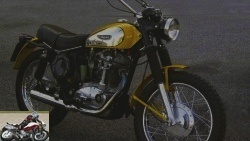 [scram-bler]: def. 2 & kind. On a motorcycle, the scrambler is thus the missing link (and highly improbable!) Between the roadster (at the time, we just called it a motorcycle) and the soft enduro machine. It has since become a genre in its own right, which dates back commercially to the Ducati 250 Scrambler from 1962, which called the competitors to come into this market in the 60s: we remember the arrival in 1965 of the Honda CL 250 and Yamaha 250 Big Bear, followed by the Kawasaki SS 250 Samurai in 1966 and the Suzuki TS 250 in 1968 Note for later: also remember that the scrambler was a small displacement motorcycle. But the race for power is written in the genes of the Moto and even Norton will make a 750 Commando Scrambler in 1970, with an improbable front fender raised (but chrome!). But the trend is changing and the species is changing, abandoning its road qualities to gain in lightness and give birth to small and medium displacement trails, Yamaha DT and others (which will eventually change into XTZ1200, the race for power is part of the genes of the Motorcycle, bis and History repeats itself). In 2006, at the beginnings of vintage fashion and in the midst of rediscovering the Steve McQueen myth, Triumph brought out the Scrambler, the look of which was furiously close to the original motorcycles! This will give ideas to other builders.
[scram-bler]: def. 2 & kind. On a motorcycle, the scrambler is thus the missing link (and highly improbable!) Between the roadster (at the time, we just called it a motorcycle) and the soft enduro machine. It has since become a genre in its own right, which dates back commercially to the Ducati 250 Scrambler from 1962, which called the competitors to come into this market in the 60s: we remember the arrival in 1965 of the Honda CL 250 and Yamaha 250 Big Bear, followed by the Kawasaki SS 250 Samurai in 1966 and the Suzuki TS 250 in 1968 Note for later: also remember that the scrambler was a small displacement motorcycle. But the race for power is written in the genes of the Moto and even Norton will make a 750 Commando Scrambler in 1970, with an improbable front fender raised (but chrome!). But the trend is changing and the species is changing, abandoning its road qualities to gain in lightness and give birth to small and medium displacement trails, Yamaha DT and others (which will eventually change into XTZ1200, the race for power is part of the genes of the Motorcycle, bis and History repeats itself). In 2006, at the beginnings of vintage fashion and in the midst of rediscovering the Steve McQueen myth, Triumph brought out the Scrambler, the look of which was furiously close to the original motorcycles! This will give ideas to other builders.
 [scram-bler]: def. 3 & business plan : the past seems to be a value for the future, we will note the strategies specific to each manufacturer in its interpretation. In opposition to an academic Triumph, Ducati embarked on its own burial of the genre in 2015, with a modern and not at all nostalgic Scrambler. The Bolognese took a good turn: the commercial box was immediately there, with more than 15,000 copies sold, including 1,500 in France.. Ducati has created for the occasion a universe of "lifestyle", where Scrambler is called to become almost a brand and has developed a whole environment for a golden and carefree youth., urban youth who picnic on the beach, surf and skate and ride motorcycles in colorful sneakers and always smiling. The concepts of virility and performance have been abandoned in favor of those of fun, freedom … And Ducati intelligently capitalizes on this with several variations (Icon, Classic, Full Throttle, Urban Enduro in 2015, doubled in 2016 by Flat Track Pro and Italia Independent). Or how to offer them for all tastes at a lower cost, without forgetting the line of accessories and clothing that goes well. It’s very trendy. Bingo !
[scram-bler]: def. 3 & business plan : the past seems to be a value for the future, we will note the strategies specific to each manufacturer in its interpretation. In opposition to an academic Triumph, Ducati embarked on its own burial of the genre in 2015, with a modern and not at all nostalgic Scrambler. The Bolognese took a good turn: the commercial box was immediately there, with more than 15,000 copies sold, including 1,500 in France.. Ducati has created for the occasion a universe of "lifestyle", where Scrambler is called to become almost a brand and has developed a whole environment for a golden and carefree youth., urban youth who picnic on the beach, surf and skate and ride motorcycles in colorful sneakers and always smiling. The concepts of virility and performance have been abandoned in favor of those of fun, freedom … And Ducati intelligently capitalizes on this with several variations (Icon, Classic, Full Throttle, Urban Enduro in 2015, doubled in 2016 by Flat Track Pro and Italia Independent). Or how to offer them for all tastes at a lower cost, without forgetting the line of accessories and clothing that goes well. It’s very trendy. Bingo !
[scram-bler-si-kse-tee-tou]: def. : we cannot blame a sales team for wanting to continue milking the cash cow. Ducati therefore declines its Scrambler down with this Sixty2 version whose surname, as we will have understood, refers to the year of the appearance of the original Ducati Scrambler, which was also a small engine. Double wink, then. By being in a way the little brother of the Scrambler, this Scrambler Sixty2 is more accessible: the air-cooled V-twin goes from 803 to 399 cm3, the power from 75 to 41 horses and the weight from 170 to 167 kilos dry . The Sixty2 is aimed at young people, A2 license holders (although the Scrambler 800 can be bridged), motorcycle ghosts, anyone who finds the 803cc Scrambler scary or those who want to save a bit of money. money for purchase and use (the Sixty2 is sold for € 7,990, the Scrambler 800 starts at € 8,590). Or to a lot of people, in fact.

Discovery
The Sixty2 is therefore a Scrambler as we have known it since its appearance in February 2015. No need to play the game of 7 errors with its big brother, since its colors are specific to it and are therefore sufficient to identify it: if you can see a black, orange or pastel blue Scrambler like the one in our test model, so it is a Scrambler Sixty2.
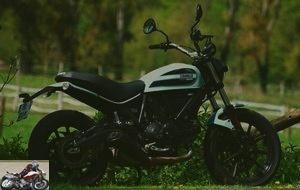
If the Sixty2 is intended for a clientele less "biker mature" than that of the traditional Scrambler, this one is however not stolen on appearances: the Sixty2 indeed uses the frame of the Scrambler and the proportions of the two models are almost identical. . The Sixty2 therefore loses nothing of the presence of its elder, nor of its charisma.
We therefore find its rounded and dapper face as well as its thick saddle which promises to take care of your seat, the small black silencer in the low position which marries the roundness of the swingarm, the mixed tires Pirelli MT-60 (but the Sixty2 gives up the 180/55 x 17 of its elder at the back for a more modest 160/60).
The rear LED light, the front optics also surrounded by LEDs as well as the digital instrument panel, quite complete, are identical to the two versions: this brings a touch of modernity to this machine of classic inspiration, even if the 400 does without the USB socket under the saddle. On the other hand, the tank loses its inserts for a painted decoration, but in the process, its capacity goes from 13.5 to 14 liters.
The Sixty2’s mirrors are round and no longer slightly ovalized and tapered. Finally, the Sixty2 hangs its license plate at the end of a classic bib, unlike the other Scramblers (except the Classic version) which house it on a remote plate attached to the swingarm. So much for the cosmetic details.
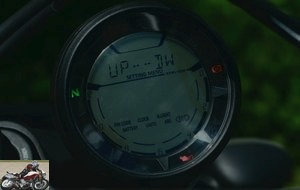
The chassis of the 400 is also simplified: if the rear shock absorber remains a Kayaba (placed laterally on the left side) adjustable in preload, the fork and the brakes are in phase with the decreasing power. The Sixty2 thus gets a conventional Showa fork with 41 mm diameter tubes and 150 mm travel (instead of an inverted Kayaba fork, of equivalent size and travel), while the front brake is entrusted to a 320 mm disc clamped by a 2 piston caliper (instead of a 330 mm disc clamped by a Brembo 4 piston caliper with radial mounting). As for the weight, it drops from 170 to 167 kilograms dry. Only three small kilos of difference? Yes, because the 400 abandons the aluminum swingarm of its big sister to adopt a steel one..
A final word on the engine: the good old Desmodue air-cooled still has this inimitable allure (and which is rarefied in front of the conversions of the Monster and Hypermotard families with all liquid cooling). That of the Sixty2 can be recognized by its treatment with a low engine in black and aluminum-style cylinder heads (the treatment of the Scrambler 800 is standardized). The explanation for this: the cylinder heads still have Ducati logos from the Texas Pacific Group era (1996), when the Monster 400 and SS 400 were sold in Japan. The high engine is therefore 20 years old, but it has been decontaminated and complies with the Euro4 standard. And, compared to the old 400s on the Japanese market, the Sixty2 block has a 6 box instead of 5…

In the saddle
It seems to have all the qualities for it, the saddle: low (790 mm), relatively wide and rather thick. With the handlebars placed high enough, the riding position is as natural as it is relaxed. The tank is thin and the footrests, despite the low saddle, do not bend the legs too much or constitute a nuisance when walking in town. In short, the Scrambler Sixty2 is indeed an easy-to-access motorcycle: an essential quality to hit the target that is yours. Curious, moreover, that the levers are not adjustable.
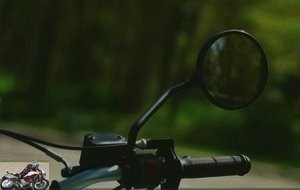
In front of you, the wide handlebars reveal the dashboard, slightly off-center on the right. This is easily controlled via buttons on the left stalk. The large round screen is generally quite readable, with the time at the top and above the mileage, the speed in large and the lights around the rim. What is less obvious to read is the tachometer by bar graph in the lower part, even if a good biker also learns to drive his machine by ear and sensations..
The Scrambler Sixty2 gives the user the choice of deactivating the ABS. To drive in town (and elsewhere, too), we will keep it.
In the city
With a push on the starter, the V-twin comes to life in a sound environment relatively far from what we are used to hearing at Ducati. With the reduced displacement (the piston bore is 72 mm against 88 for a Scrambler), the muffled rumblings of the beautiful Bologna mechanics are necessarily more discreet. Ditto for the clutch which, in both cases, is entrusted to a multi-disc system in an oil bath, for the benefit of smooth and easy changes. Fans of castanets (and dry clutches, Borgo-Panigale’s long acoustic signature), cry.

The "side-stand" indicator is displayed as a reminder on the instrument panel. Placed back and far enough inside, it is not always easy to unfold.
Contained weight, reduced dimensions, low saddle, relatively narrow tires: here are all the ingredients for successful urban mobility. And it is an understatement to say that the Scrambler Sixty2 seems designed for the City: agile, manoeuvrable, easy, it is in its natural environment. With a small drawback for the handlebars, high and relatively wide, which passes over the mirrors of cars, but not of utilities or SUVs: if you are therefore on a relatively narrow biroute, you risk getting stuck between Armindo, mason driving his Renault Trafic and Piotr, plumber, driving his Opel Vivaro; but also, no sectarianism, between Jean-Frederic and his Porsche Cayenne and Marie-Chantal and his Range Rover. For the rest, the Scrambler Sixty2 delights in the city with gluttony. Braking necessarily has an ABS and the smoothness and progressiveness of its control is to be cited as an example. Here, there is no risk of being surprised by a bite that is too violent. The turning radius is excellent.

What about the engine in all of this? It is flexible, necessarily, accepting to resume from 2000 rpm on the intermediate reports. On the other hand, to drive in the city, you do not necessarily need all 41 horses. But you need a little torque: this is where the shoe pinches, since the Sixty2 delivers the modest value of 3.5 m / kg at the high speed of 8000 rpm. Translation: it’s soft. Very soft. Admittedly, a sudden little blow of gas at 2000 rpm in first and the Sixty2 leaps forward: it makes an impression. But on intermediate ratios, around 4000 rpm (i.e. the configuration of flexible, responsible and peaceful urban driving), the Scrambler Sixty2 evokes, let’s say it, a Honda 125 Varadero (which is also an excellent motorcycle) : the little V2 purrs in a muffled way, but by resuming with a trickle of gas, not much happens. Two solutions: anticipate as on the handlebars of a small displacement (which the Sixty2 is, even if it does everything to make people forget it), where to get the horses higher in the towers.
On motorways and main roads
Few 40-horsepower machines are true long-haul, capable of going both fast and far. By having less in the connecting rods, it is normal that the Sixty2 turns faster than the Scrambler: with a transmission in 15 x 48 (instead of 15 x 46), it grinds a little and is already found a little above from 7,500 to 130 km / h in sixth gear (maximum power is delivered at 8,500 rpm). In short, to travel from Paris to Marseille by the A6, we will find better.
Especially since the relaxed driving position, with the handlebars high enough, induces a certain catch in the wind and that the Scramblers offer no protection. Stability at "high" speed is not a problem. The Scrambler Sixty2 is worth a small 160 km / h chrono, but we will have understood that speed is not its primary vocation.
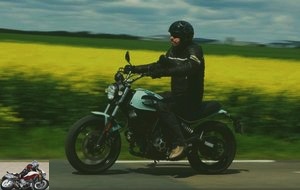
On departmental
A Scrambler is rustic (reread definition n ° 1) and the little ribbons of asphalt winding through the undergrowth are much more in tune with its philosophy. On departmental, in sixth, the small twin does not turn more than 5000 rpm at 90 km / h. The pickups are still nothing short of mind-blowing, but the bike is still proving to be just as agile and easy to handle..
And the Scrambler Sixty2 does not deprive itself of a small "double effect Kiss Cool©": while we thought to definitively classify its mechanics in the family of knee softness, it suddenly wakes up between 7000 and 10000 rpm, with a vigor that one would not have suspected earlier in urban use. And there, it becomes very fun: a kind of fun accessible to those who have the chakras open enough to appreciate all the charms of medium-displacement: pleasurable liveliness, absence of inertia when entering a bend, little engine braking , never unpleasant surprises because of the weight … So yes, when you get into it badly, the Scrambler Sixty2 is playful and it’s more of a discovery.
However, with two caveats: does the target clientele want to drive to the limits? Not sure … And pushed to its limits, the Sixty2 reveals a rear shock absorber quickly exceeded and a really modest braking, where the weak initial bite does not lead to a consequent power, even with the lever in full stop..
The Scrambler Sixty2 therefore remains a motorcycle for beginners or peaceful bikers. We will therefore be content to praise the ease with which it lets itself be taken at a walking pace.

Part-cycle
The solutions are simple and proven. The trellis frame is part of Ducati’s DNA, the fork is entrusted to Showa (it is of a traditional design, with 41mm diameter tubes) and the rear shock absorber to Kayaba. In both cases, the suspension travel is 150 mm. Only the shock absorber is adjustable, with spring preload.
The wheelbase is 1460 mm and the caster angle is 24 °, a good combination to offer both agility and stability..
In its vocation to be a motorcycle accessible to a wide audience, Ducati offers for the Sixty2 a low saddle (770 mm) and a high saddle (810 mm).

Brakes
With a contained weight of 167 kilos dry (Ducati announces 183 kilos with 90% of the full), two discs can be enough. At the rear, the device is entrusted to a 245 mm element clamped by a single-piston caliper and the front is equipped with a simple 320 mm disc with 2-piston caliper. ABS is of course standard.
Given the vocation of the motorcycle, Ducati has privileged accessibility and ease: the system is therefore both progressive and easily dosed. Those who are able to take the bike to its limits will then find the braking power a bit tight in absolute terms..
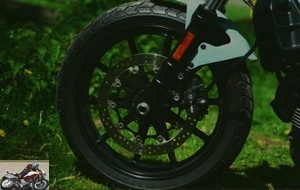
Comfort / duo
How thick it looks, this saddle! Here is a good slice of about ten centimeters thick which should do good to the foundation. But the Scrambler saddle is proof that you have to beware of appearances! In fact, it’s super hard and painful quickly (the forums dedicated to the Scrambler 800 are swamped with threads relating to changing saddles). Especially since the fairly cool driving position, with the arms high enough and the pelvis a bit rounded, you are directly placed on the tailbone. And there, double penalty! The frankly low-end rear shock sends you racket blows to blow your fillings at every pothole.
At the rear, the saddle is a little more generous. The handles are hidden underneath, which implies having a passenger having finished his growth at the level of the arms. And having only fairly weak notions in terms of damping.
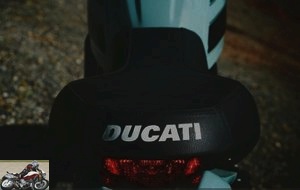
Consumption, autonomy, practical aspects
You can see it: the practical aspects are limited to a very small location under the saddle which can accommodate a small rain pants (provided they are very strong in folding) or a micro disc lock. That’s already it and the Scrambler has never claimed to be an alternative to a scooter.
The small V-twin, on the other hand, is rather sober. Count barely 4 l / 100 while driving cool, less than 5 l by pulling it in. Autonomy can then easily exceed 300 kilometers. But with the original saddle, we bet you won’t do them in one go.
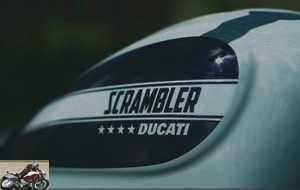
Conclusion
Who could have predicted that a machine so simple in its mind and in its letter would be so complex to evaluate? ?
From a strictly rational point of view, the economic equation does not hold water. When we see the gap in mechanical and dynamic performance, the difference in the quality of the equipment (brakes, suspensions) and the 600 € that separate it from a Scrambler 800, we say to ourselves that these € 600 will be the best spent of motorcycle planet.
But at Ducati, we think that there is a clientele for whom the price is not a problem and for whom the technical and dynamic qualities are secondary. The motorbike thus becomes a foil, accessory of a "lifestyle" made up of wrinkles on the beach and a world repainted in acidulous colors, too bad if the attachment to the object suffers from frivolity and that it competes with other lifestyle objects. It does have the advantage of being an aesthetic proposition for A2 licenses. Finally, the sales figures at the end of the year will be the verdict on whether there is a large clientele in France for this proposal..
In short, we could stop there and conclude, lapidly, that the Sixty2 is too expensive for what it offers. That’s true, but it’s also not the only machine in this case. Because we can ultimately crack for its good face, its ease in town, its demonic agility, its engine more flexible than that of its big sister and have sympathy for the mid-size sensations it delivers on small roads. On a motorcycle, simplicity and decrease are also virtues. And in the small world of 400 cm3, it has no real competition, being still significantly more powerful and sophisticated than a Mash or a Yamaha SR.
As is often the case with test vehicles, my conscience as a journalist makes me ask myself this question: "and if we gave it to you, could you live with it?". Do not believe, there are not that many "yes" that that. And in the case of the Scrambler Sixty2, it would be more like a "yeah", but on condition of changing the rear shock absorber.
Strong points
- Obvious grip
- Scrambler spirit intact
- Good tangy boil
- Easy in town
- Fun in the countryside (the joys of a small engine!)
- Efficient engine / autonomy
- The cheapest Ducati !
Weak points
- Excessive price
- Low-end peripherals (brakes, suspensions)
- Not easily readable tachometer
- Comfort
The technical sheet of the Ducati Scrambler Sixty2
Test conditions
- Itinerary: a short trial week and 250 km in and around Paris
- Motorcycle mileage: 2500 km
- Problem encountered: none
The competition: Rolex Submariner 116610 LV, Longboard Billabong Rusty Occy Limited Edition, Fender Stratocaster, a week by the sea on a paradise island, breast implants…
(or even: Mash 400 Scrambler, Yamaha SR 400, Ducati Scrambler)
Related articles
-
V2, 821 cm3, 109 hp at 9,250 rpm, 86 Nm at 7,750 rpm, 180 kilos dry, from 11,450 € Ducati’s mid-size roadster is getting a makeover and fine-tuning the…
-
Ducati Scrambler Cafe Racer test
A more sporty version of the Scrambler with a neat look The Scrambler V2, 803 cm3, 75 hp at 8,250 rpm, 68 Nm at 5,750 rpm, 172 kilos, € 11,290 About 2000…
-
Ducati Multistrada 1260 S test
V2, 1262 cm3, 158 hp at 9,500 rpm, 13.2 m / kg at 7,500 rpm, 235 kilos with full tank, from € 20,790 More torque at the usual speeds for this big stylish…
-
Ducati Panigale V4 S motorcycle test
The price of the exception V4, 1103 cm3, 214 hp and 124 Nm, 195 kg all full facts, 28,890 euros The bike that was being born was obviously exceptional:…
-
V2, 803 cm3, 75 horsepower at 8,250 rpm, 68 N.m at 7,750 rpm, 191 kilos dry, from € 11,290 (in red) If it claims to evoke trips in the Californian…
-
Moto Morini Scrambler 1200 test
The time machine. Moto Morini relaunches its production, on an artisanal scale, with a simplified range where the 9 disappears. ½. Among the 3…
-
A power cruiser with Italian sauce. Punch, style, noise, character ! V2 1262 cm3, 152 hp at 9,500 rpm, 12.8 m / kg at 5,000 rpm, 220 kilos dry, from…
-
Ducati Multistrada Enduro test
160 hp at 9,500 rpm, 13.9 m / kg at 7,500 rpm, 4 driving modes, 257 kilos, € 21,390 A super sophisticated sports trail with proven versatility Let no one…
-
Ducati Monster motorcycle test
Salon revolution V-Twin Testastretta of 937 cm3, 111 hp, 93 Nm, 166 kg dry (188 kg full made), 11,290 euros Is a Monster still a Monster if it doesn’t…
-
For a few more horses Ducati overhauls its Hypermotard by giving it a little more boot with the 939 version. We were able to discover two of the three…